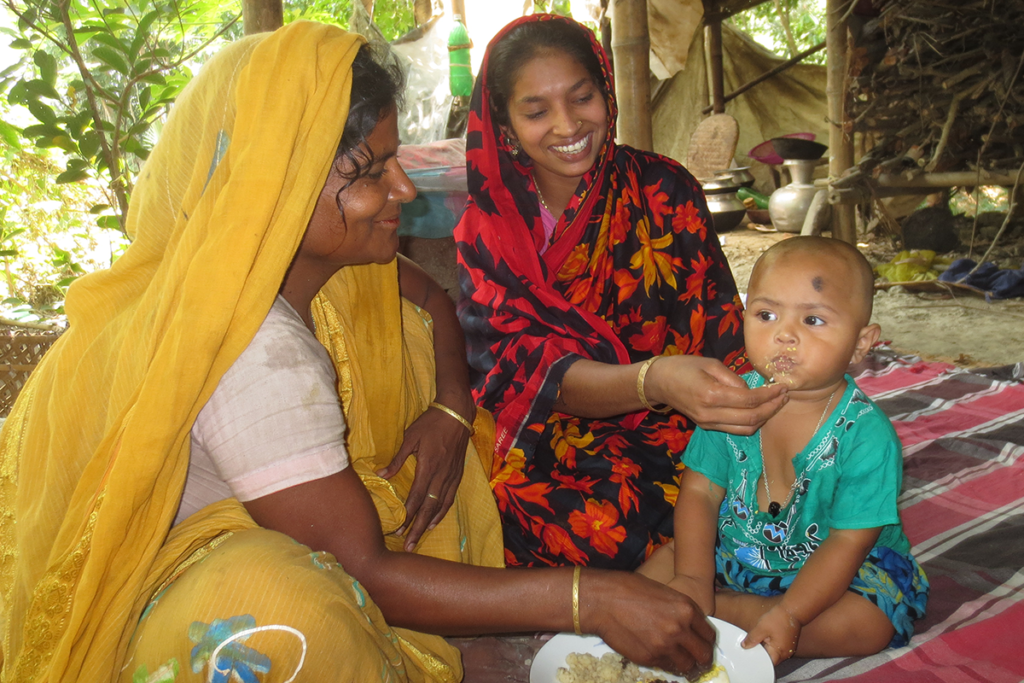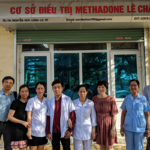How many proven effective public health projects have you been involved in that have been scaled-up to have national – or even global – impact? Those of us working in this field know it’s all too rare for an intervention to catch on and spread like wildfire. Rather, most successful interventions fizzle out when project funds dry up or donor interest is gone.
We know reducing stunting requires a multisectoral response (Bhutta, 2008; Bhutta, 2013), yet we don’t know how to implement at scale the right mix of interventions in a particular country context. This knowledge gap holds true in Bangladesh where a number of nutrition interventions have proven effective in country. FHI 360’s Alive & Thrive project achieved significant changes in child feeding practices through intensive interpersonal counseling, mass media, and community mobilization. Results from the cluster randomized program evaluation conducted in 2014 show an increase from 48.5 to 87.6 percent (p < 0.001) in exclusive breastfeeding during the first six months.
An intervention using a randomized controlled trial (RCT) implemented by the International Food Policy Research Institute (IFPRI) in partnership with the UN’s World Food Programme in 2014 decreased stunting by 7.3 percent when cash transfers were combined with nutrition behavior change. This decrease was nearly three times the national average decline.
In Bangladesh, there are also positive associations between homestead food production (HFP) and consumption of nutritious food, which is correlated with young child nutritional status. HFP is a combined agricultural-livelihood intervention that empowers women to cultivate nutritious fruits and vegetables and at times raise small-scale livestock or fish; provides nutrition education; and links households to markets to sell surplus products for income generation. Evaluations of Helen Keller International’s HFP program measure significant improvements in household production and consumption (of both vegetables and animal sources of protein), particularly in children and in pregnant and lactating women.
However, the question remains: which approaches in which combination are affordable and feasible for widespread implementation by the Government of Bangladesh? To help answer this question, FHI 360 is implementing two simultaneous, independent studies examining different sets of intervention packages.
| Figure 1: Study 1 Intervention packages/Arms | |
|---|---|
| Arm 1 | Standard practice (control) |
| Arm 2 | HFP via retailers |
| Health and other service strengthening, plus referrals | |
| SBCC (addressing nutrition, WASH and gender-related behaviors) | |
| Arm 3 | HFP via community farmers |
| Health and other service strengthening, plus referrals | |
| SBCC (addressing nutrition, WASH and gender-related behaviors) | |
In the first study (Figure 1), our team is conducting a cluster RCT in Khulna and Barisal. We are comparing the cost-effectiveness of current standard practice with two multisectoral intervention packages implemented using two different approaches: 1) HFP supported by community farmers, social and behavior change communication (SBCC), and health and other service strengthening and referrals; and 2) HFP supported by retailers, SBCC, and referrals to health and other services. We are assessing the effectiveness of the different interventions in terms of the percentage of children ages 6-24 months receiving minimum acceptable diet measured using surveys conducted before and after intervention implementation with mothers of under-2 children.
| Figure 2: Study 2 Intervention packages/Arms | |
|---|---|
| Arm 1 | Standard practice (control) |
| Arm 2 | Health and other service strengthening, plus referrals |
| SBCC (addressing nutrition, WASH and gender-related behaviors) | |
| Arm 3 | Conditional cash transfers |
| Health and other service strengthening, plus referrals | |
| SBCC (addressing nutrition, WASH and gender-related behaviors) | |
In the second study (Figure 2), our team is again conducting a cluster RCT in Khulna and Barisal. Here we are comparing the cost-effectiveness of current standard practice with two different multisectoral intervention packages: 1) health and other service strengthening and referrals, and enhanced SBCC; and 2) health and other service strengthening and referrals, enhanced SBCC, and cash transfers conditional on a woman’s participation in antenatal care and SBCC. Like the first study, this one examines the relative cost-effectiveness of the alternative interventions using the percentage of children receiving a minimally acceptable diet.
To determine costs over and above current standard practice, and to assess implementation experience and factors influencing intervention success, we will complement these two studies with cost analyses, process evaluations, and qualitative inquiries. Combined, these studies will provide evidence on: 1) the relative cost-effectiveness of different approaches for delivering multisectoral nutrition interventions; 2) the affordability, feasibility, and acceptability of implementing the different interventions; 3) the factors influencing successful implementation in real-world contexts; and 4) the ways in which multisectoral interventions influence child nutrition.
In Bangladesh we may see malnutrition addressed at scale in the near future. FHI 360’s work certainly aims to help make this happen. And a great starting point is a government with this end-point in mind from the outset, and a donor actively supporting this learning effort.
Photo caption: A mother feeds her child complementary foods, including animal-source foods such as egg, with her mother-in-law in Khulna, Bangladesh.
Photo credit: © 2014 SPRING Project, Courtesy of Photoshare



